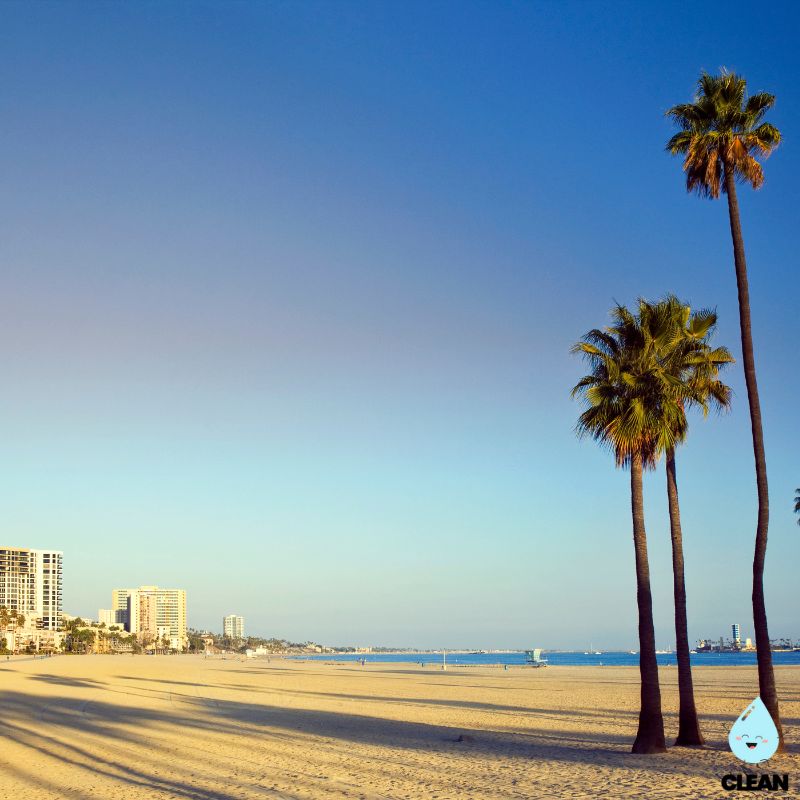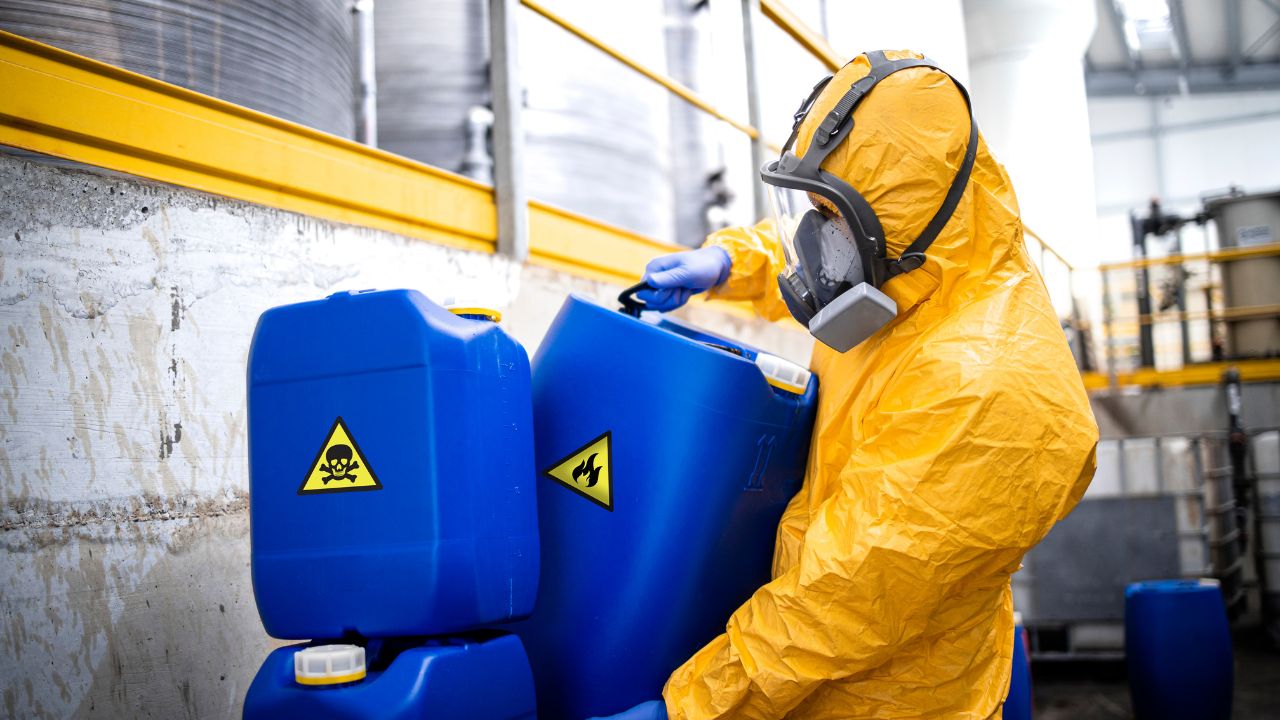Long Beach Water Quality at a Glance
some concerns
Is Long Beach Water Safe to Drink?
Generally Yes, With Some Caution – Long Beach water meets federal standards and is considered safe for consumption. However, chromium-6 levels average 63 ppt, which is 3 times higher than California’s cancer risk benchmark. The water also contains elevated disinfection byproducts (DBPs) including chloroform and haloacetic acids that form during water treatment and are linked to increased cancer risk.
⚠️ Key Concerns for Long Beach Residents
- Chromium-6 (Hexavalent Chromium): Average 63 ppt detected – 3x higher than California’s public health goal of 20 ppt; linked to cancer risk
- Disinfection Byproducts (DBPs): Elevated levels of chloroform, bromodichloromethane, and haloacetic acids from chlorination treatment
- Water Sources: 58% from local groundwater wells, 42% from Colorado River – both sources susceptible to contamination
- Regional PFAS Risk: While Long Beach specific data limited, California monitoring shows widespread PFAS contamination affecting 25+ million residents statewide
Read the full report below for detailed analysis, water source information, and actionable recommendations for Long Beach residents.
Long Beach – California – Water Quality Report 2025: PFAS Testing, Infrastructure Concerns & Safety across your city
Long Beach Utilities provides comprehensive water services to approximately 458,000 residents in the second-largest city in Los Angeles County. The utility has been delivering safe and dependable water supply for over 100 years, operating through a dual-source system that combines local groundwater from the Central Groundwater Basin with imported water from the Colorado River and Northern California’s Bay-Delta region. The system encompasses approximately 30 active groundwater wells and extensive distribution infrastructure, delivering water to one of California’s most diverse metropolitan areas.
Long Beach sources approximately 58-60% of its drinking water from local groundwater wells located in the Central Groundwater Basin, with the remaining 40-42% purchased from the Metropolitan Water District of Southern California. About 25% comes from the Colorado River via the 242-mile Colorado River Aqueduct, and the rest comes from Northern California’s Bay-Delta region via the 441-mile California Aqueduct. The utility operates two major reservoirs – the Alamitos Reservoir serving the eastern “blended zone” and the Johnson Reservoir serving western areas. Long Beach maintains excellent water conservation practices, with residents using only 63 gallons per person daily compared to the regional average of 94 gallons, demonstrating the community’s commitment to sustainable water use in an era of increasing climate challenges.

Long Beach Water Quality: Current Status (2024-2025)
Latest Testing Results
- Comprehensive Testing Program: Long Beach Utilities performs thousands of tests each year to ensure that the drinking water meets or exceeds all federal and state water quality standards, maintaining compliance with EPA and California Division of Drinking Water regulations.
- Testing Scope: Regular monitoring includes bacterial, chemical, and physical quality parameters across both groundwater and imported water sources throughout the distribution system.
- Compliance Status: Long Beach’s water consistently meets all federal and state drinking water standards, with continuous monitoring at treatment facilities and throughout the distribution network.
- Chromium-6 Concern: Recent testing shows chromium-6 levels averaging 63 parts per trillion, which is 3 times higher than California’s public health goal of 20 ppt for cancer risk protection.
Water Sources
- Local Groundwater (58-60%): Water extracted from the Central Groundwater Basin through approximately 30 active wells located primarily in eastern and northern parts of the city, providing sustainable and cost-effective local supply.
- Colorado River (25%): Imported water from the Colorado River via the 242-mile Colorado River Aqueduct, which gets its water from the Rocky Mountains and ventures through seven states, delivered through the Metropolitan Water District.
- Northern California (15-17%): Additional imported water from Northern California’s Bay-Delta region via the 441-mile California Aqueduct, providing supply diversity and reliability.
Advanced Treatment Technology
- Groundwater Treatment: Groundwater is extracted through well pumps and treated at treatment facilities before being distributed to two reservoir systems, ensuring quality and safety.
- Dual Reservoir System: The Alamitos Reservoir serves the eastern “blended” zone with a mix of groundwater and imported water, while the Johnson Reservoir serves western Long Beach with primarily imported water.
- Gravity Distribution: Both reservoirs are situated on higher ground, allowing water distribution throughout the city primarily by gravity, enhancing system reliability and reducing energy costs.
Infrastructure Modernization
- Well Expansion Program: Long Beach is investing in groundwater infrastructure, including new groundwater wells to increase local supply while reducing imported water dependence. The first new well since 2003 came online in 2023.
- Recycled Water Systems: Planned expansion of recycled water systems to increase usage from current levels to approximately 9,000 acre-feet annually, supporting industrial and irrigation operations.
- Water Conservation Leadership: Long Beach residents use only 63 gallons per person daily compared to the regional average of 94 gallons, demonstrating effective conservation programs and Stage 2 water shortage restrictions.
Customer Protection Initiatives
Long Beach Utilities provides extensive customer support through various programs and maintains transparency through annual water quality reports available to all customers. The utility has operated for over 100 years, with skilled staff ensuring that drinking water meets or exceeds all federal and state standards. The utility’s investments in groundwater expansion, recycled water programs, and conservation initiatives demonstrate its commitment to providing safe, reliable drinking water while preparing for future challenges including population growth, climate variability, and emerging contaminants like PFAS. With new EPA PFAS regulations requiring compliance by 2029, the utility is preparing monitoring and treatment protocols to address these emerging contaminants.
Recommendations for Long Beach Residents

Monitor Water Quality
Contact Long Beach Utilities at (562) 570-2390 for water quality concerns or questions. Stay informed about water quality through annual Consumer Confidence Reports and monitor beach water quality at Long Beach’s 7 miles of coastline through the city’s weekly testing program.

Continue Water Conservation
Support Long Beach’s water conservation leadership by following Stage 2 water shortage restrictions, including outdoor watering limited to two days per week. Take advantage of conservation programs and water-efficient fixtures to maintain the city’s impressive 63 gallons per person daily usage.

Consider Chromium-6 Protection
With chromium-6 levels at 63 ppt (3x higher than health goals) and new EPA PFAS regulations taking effect by 2029, consider NSF-certified water filters for drinking and cooking water to reduce exposure to these contaminants.

Support Recycled Water Programs
Learn about Long Beach’s recycled water expansion plans to increase usage to approximately 9,000 acre-feet annually. Support industrial and irrigation operations using recycled water to reduce demand on potable water supplies.

Report Issues
Contact Long Beach Utilities Customer Service at (562) 570-2390 for water quality concerns, pressure problems, or service issues. For beach water quality information, call Environmental Health at (562) 570-4132 between 8:00 AM and 5:00 PM, Monday through Friday.
Frequently Asked Questions
Is Long Beach’s tap water safe to drink?
Yes, Long Beach’s tap water meets all federal and state drinking water standards. Long Beach Utilities has been delivering a safe and dependable water supply for over 100 years, with skilled staff ensuring that drinking water meets or exceeds all water quality standards.
The utility performs thousands of tests annually across both groundwater and imported water sources. However, residents should be aware that chromium-6 levels average 63 ppt, which is 3 times higher than California’s public health goal of 20 ppt for cancer protection. The dual-source system provides backup reliability and the gravity-fed distribution system enhances safety and reliability.
What about PFAS contamination in Long Beach water?
PFAS (per- and polyfluoroalkyl substances) are emerging contaminants being monitored statewide. In April 2024, EPA finalized drinking water standards for six PFAS compounds with water systems required to begin monitoring by 2027 and comply with new standards by 2029.
Long Beach Utilities is preparing for these new requirements. California has been expanding PFAS testing, with statewide data showing up to 25 million Californians potentially affected by PFAS contamination. Testing data shows PFAS detection varies by location, and utilities are implementing treatment technologies where needed.
Residents concerned about PFAS exposure can use NSF-certified water filters for drinking and cooking water while utilities prepare for compliance with new federal standards.
Are there water restrictions in Long Beach?
Yes, Long Beach is currently in Stage 2 of its water shortage plan, which limits outdoor watering to two days per week. This has contributed to the city’s excellent conservation record.
Stage 2 Water Shortage Restrictions:
• Outdoor watering limited to two days per week
• Restrictions on timing and methods of irrigation
• Conservation measures for commercial and industrial users
Conservation Success:
Long Beach residents use only 63 gallons per person daily compared to the regional average of 94 gallons, demonstrating exceptional community commitment to water conservation. The utility expects to remain in Stage 2 until regional water supply conditions improve.
How is Long Beach preparing for future water challenges?
Long Beach is investing in infrastructure to increase water security and reduce reliance on imported sources:
Groundwater Expansion:
The utility has brought the first new groundwater well online since 2003 and continues well expansion projects to increase local groundwater supply and reduce dependence on imported water.
Recycled Water Programs:
Planning recycled water expansion to increase usage to approximately 9,000 acre-feet annually, supporting industrial and irrigation operations while reducing demand on potable supplies.
Colorado River Challenges:
With ongoing Colorado River drought and federal water cuts, Long Beach’s investment in local groundwater becomes increasingly important for long-term supply security.
Quality News About Your Water
Get the comprehensive water quality news coverage you need with our dedicated US Water News Service. From coast to coast, we deliver in-depth reporting and expert analysis on PFAS contamination, EPA regulatory changes, infrastructure developments, and emerging water safety issues affecting communities nationwide. While mainstream media only covers the biggest stories, we provide the detailed, ongoing coverage that helps you understand the full scope of America’s water challenges. Whether you’re a concerned citizen, water professional, or community leader, our daily updates and analytical insights keep you informed about the issues that matter most to public health and environmental safety.
Contaminants of Concern

PFAS Compounds
Source: Per- and polyfluoroalkyl substances from industrial processes, firefighting foams, and consumer products that can enter both groundwater and surface water sources
Health Effects: Research suggests potential concerns including impacts on immune system, thyroid function, cholesterol levels, cancer, and developmental effects
Current Status: New EPA regulations finalized in April 2024 require water systems to monitor for six PFAS compounds by 2027 and comply with new maximum contaminant levels by 2029. California statewide monitoring shows widespread contamination affecting up to 25 million residents. EPA Limits: Individual MCLs for PFOA, PFOS, PFNA, HFPO-DA, PFHxS, and PFBS, plus a Hazard Index for PFAS mixtures

Chromium-6 & Disinfection Byproducts
Source: Chromium-6 from industrial pollution or natural mineral deposits; disinfection byproducts formed when disinfectants such as chlorine react with naturally occurring organic matter in source water
Health Effects: Chromium-6 is linked to cancer risk; disinfection byproducts may increase risk of certain cancers and potentially affect liver, kidney, and central nervous system
Current Levels: Long Beach chromium-6 levels average 63 ppt (3x higher than CA health goal of 20 ppt); disinfection byproducts monitored regularly with levels maintained below EPA maximum contaminant levels. EPA Limits: 80 ppb for total trihalomethanes (TTHMs) and 60 ppb for haloacetic acids (HAA5)
Please read – our information
The information presented on cleanairandwater.net is compiled from official water quality reports, trusted news sources, government websites, and public health resources. While we strive for accuracy and thoroughness in our presentations, we are not scientists, engineers, or qualified water quality professionals.
Our mission is to present water quality information in an accessible, real-world format that helps people understand what’s in their water and make informed decisions about their health and safety. We believe that complex environmental information should be available to everyone in a format that’s easy to understand.
We make every effort to ensure our content is current and accurate, but we cannot guarantee that all information is complete or error-free. This website should not replace official communications from your local water utility or health department. We always recommend consulting official sources for the most up-to-date information regarding your specific water system.
Clean Air and Water is not liable for any unintentional errors, omissions, or outdated information. The content on this site is provided for informational purposes only and should not be considered professional advice.


